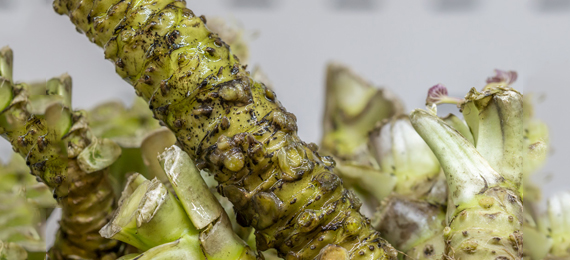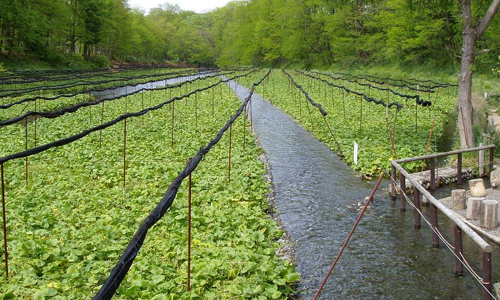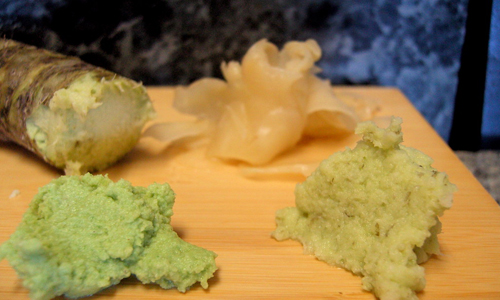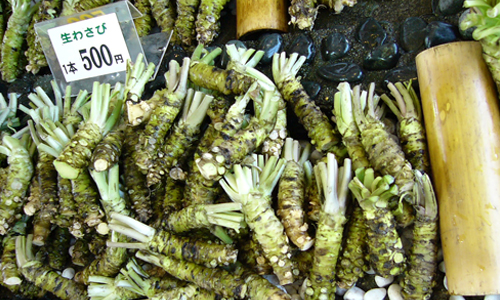
Forget the firecracker green paste! That ubiquitous condiment served with your sashimi or sushi is most likely an imposter. The real deal is a rare and expensive treat.
Genuine wasabi, a relative of horseradish, boasts a subtle pale green hue and a complex heat that builds gradually. However, its short shelf life and high price make it a luxury most restaurants can’t afford. So, next time you visit a Japanese eatery, enjoy the delicious alternative – but remember, it’s not the true wasabi experience.
What is Wasabi & How it is made of

What is wasabi?
- A. Member of the plant family Cactaceae
- B. Flowering plants in the mint family
- C. Green plant in the Brassica family
- D. Flowering plant of the genus Rosa
Wasabi is a green plant in the brassica family that contains other types such as radishes, mustard plants, and horseradishes. This is made from the rhizome, the underground stem part of the plant. This stem part is grated to get the exact paste. That’s why, it has the best taste once it is fresh.
Apart from wasabi, have you heard of shamrock? These are clover-like plants with three-lobed leaves, used as the national emblem of Ireland. Want to know more about it? Explore these interesting things about shamrock.
What Does Real Wasabi Look Like
wasabi has a more delicate appearance compared to the glowing green gloop that frequently accompanies sushi. It takes on a light green hue not dissimilar from a recently grated horseradish and feels particularly silky when eaten fresh in a meal prepared by a true lover of sushi. The reason behind this is that it is essentially the root of wasabi that has been grated as opposed to having color added using synthesized materials. This is why only expensive sushi bars have it because its flavor diminishes rapidly rendering it unfit for consumption unless it is grated off from scratch every time one orders the dish.
Wasabi Benefits
Wasabi mostly grows in parts of Korea, China, North America, and New Zealand. Here you can know some of the benefits.
1, Boosts the Immune System
Wasabi contains high amounts of Vitamin C and other compounds that help fight off infections. You can follow a wasabi-inclusive diet with proper exercise and sleep. It is beneficial for boosting your immune power and overall healthy style.
2. Supports Heart Health
Another unique property of real wasabi is to promote your heart health. Adding wasabi to your diet allows you to improve blood circulation and reduce cholesterol.
3. Reduce Cancer Risk
The consumption of wasabi may hinder the growth of certain cancer skills especially for breast and colon cancer. It is because of the isothiocyanate compounds in wasabi that may have anticancer properties.
4. Aids in Lose Weight
Adding a little bit of wasabi into your diet aids in fat loss. Because of its thermogenic effects, wasabi improves metabolism and your body burns more calories. Also, it can reduce your food cravings and appetite because of its strong spicy flavor. It is the best component in your weight loss journey.
How Wasabi is Cultivated?
Cultivating wasabi is no easy feat. It thrives in a very specific environment and requires meticulous care.
Demanding Diva: The Wasabi Plant’s Needs
Cool and Shady: Wasabi is a shade-loving plant that prefers consistent coolness. Ideal temperatures range between 45°F and 75°F (7°C – 24°C) with minimal fluctuations.
Hydration Hero: This plant requires consistently moist, well-drained soil. Think babbling brook, not stagnant swamp. Flowing or constantly replenished water is often necessary.
Going Green: Wasabi struggles in direct sunlight. Shade cloth or a natural canopy from trees is essential to mimic its natural forest habitat.
Cultivation Techniques:
Streamside Paradise: The ideal scenario is to replicate a natural streambed. Running water channels are built with rocks and gravel to provide both moisture and drainage.
Some farms have been operating successfully for centuries using this method.
Underwater Oasis: Greenhouse and hydroponic systems have been attempted with limited success. These methods are expensive and require constant monitoring to maintain the delicate balance of moisture and temperature needed for wasabi to thrive.
Seedlings or Segments?: Wasabi can be propagated from seeds or rhizome segments (the rootstalk). Seeds take longer to mature, while rhizome segments offer a quicker harvest but can be expensive to obtain.
How to Grow Wasabi
Wasabi plants require up to three years to mature enough for harvesting the rhizome, the condiment part. Due to its slow growth and specific requirements, this perennial plant demands patience.
Real Wasabi vs. Imitations

Wasabi is widely available in most Japanese food restaurants. Most individuals who eat it outside of Japan have probably tasted the fake one. Wasabi plants are native to Japan, so trying a real one outside can be difficult.
Real wasabi is not very spicy and it offers the delicate taste of fish. On the other hand, fake wasabi has a strong taste and delivers a strong blast of spiciness. You can get fake wasabi everywhere, especially in stores, restaurants, and online.
Nature is full of mysteries and mushrooms are no different. Here are the weirdest mushroom facts that you must know.
How Much Does Real Wasabi Cost

It is one of the most expensive crops in the world because it only grows in specific environments. That’s why most people outside Japan have never tasted the real one.
Wasabi plants require specific conditions and are difficult to grow, hence they are quite expensive.
In Japan, most of these plants grow naturally in mountain river valley areas. The cultivation of wasabi plants on a commercial level is the toughest task. Shimane prefecture, Nagano prefecture, and Shimane prefecture are best known for the production of wasabi in Japan.
Have you heard about floating gardens? If not, look at these jaw-dropping floating gardens of the world.
If you are wondering what wasabi is, now you have an idea about the health properties of authentic wasabi. Have a try on wasabi and experience the delicate taste.